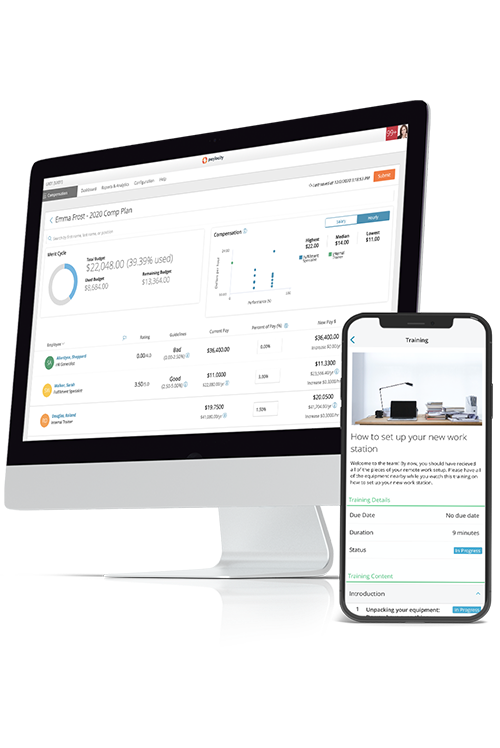| Manager Stay Interview Questions | HR Stay Interview Questions |
|
|
resources
How to Conduct Stay Interviews to Maximize Retention
August 07, 2023
Learn about the stay interview and how HR teams can use them to engage and retain their current employees.
Blog Post

As the war for talent rages, organizations must take care to preserve the talent they already possess. This is why some human resources professionals are turning to a fresh tactic in this battle: the stay interview.
Stay interviews uncover useful, actionable insights to create an environment that attracts new talent and retains your employees.
But how can HR scale this 1-to-1 approach with such limited resources?
Read on to learn about the stay conversation and how you can incorporate them into your employee engagement strategy.
Key Takeaways
- A stay interview is a one-on-one meeting between a current employee and their manager designed to glean insights into why employees stay at an organization.
- HR pros can use this information to identify pain points and implement solutions before an employee considers leaving their role.
- To make the most of stay interviews, be sure to communicate employee feedback to leadership and determine actionable next steps to remedy any uncovered issues.
What Is a Stay Interview?
A stay interview, sometimes called a retention interview or stay conversation, is a one-on-one meeting between a current employee and their manager. During a stay interview, managers ask employees pre-determined questions so they can glean insights into why employees stay at the organization—and what might risk them leaving.
Equipped with this valuable information, managers can identify challenges and implement solutions before an employee may consider leaving their role. Stay interviews work best when there’s a culture of trust at the organization, so employees feel comfortable sharing their perspectives and voicing concerns.
What is the Purpose of a Stay Interview?
The purpose of a stay interview is to get the conversation started when there’s still time to course correct. They can improve managers’ relationships with their direct reports, enabling them to intercept any at-risk talent and give HR teams crucial workforce-level insights to build lasting culture and connection. On a larger scale, these insights allow organizations to learn what employees care about personally and professionally, helping them understand what really motivates an employee to remain at a job.
“Organizations have their perception about what they value, but that mindset doesn’t always align with their employees. They may think that employees like hanging out at the office because they get free food, but employees think it’s a great opportunity to interact with their peers and connect with people in different departments. A stay interview helps organizations discover what truly sets them apart.”
- Calvin Sun, Senior Director Comp Benefits and Talent Analytics, Paylocity
The stay interview gives employees the opportunity to voice their feelings, which makes employees feel valued and important — and more willing to offer feedback next time. And questions are designed to directly identify issues that impact company culture, employee engagement, personal wellness, career development, and more. Using these retention interviews in addition to other strategies can help you be proactive and make impactful improvements to your work environment.
Stay Interviews vs. Exit Interviews
Both stay interviews and exit interviews are essential features of an employee retention and engagement strategy. But the value they provide and the approach organizations take in conducting them differ.
| Exit Interviews | Stay Interviews |
|
|
Successful outcomes for these interviews depend on how well the interviewer uses active listening skills and how comfortable the employee is sharing.
How to Conduct Stay Interviews
To conduct stay interviews successfully, keep your process structured, simple, and straightforward.
- Identify employees to interview: You don’t need to interview every single employee right away. Focus on both high performing employees and at-risk employees first. Each can provide valuable information about the health of the employee lifecycle.
- Decide on a frequency: How often organizations schedule stay interviews depends on their needs, but at least once per year is optimal.
- Determine when to schedule interviews: Keep stay interviews separate from annual performance reviews. Otherwise, schedule all stay interviews within a brief time frame — days or weeks — so gathering and applying insights is timely.
- Designate an interviewer: It’s best to have managers interview direct reports because they’ve built rapport and established trust, which makes it more likely for the employee to share candidly. If a manager doesn't have experience conducting stay interviews, upskill them before the interview for better outcomes.
- Schedule the interview: Notify the employee ahead of time so they’re in the loop. Make sure you provide enough time to have a meaningful conversation. Stay interviews usually take anywhere from 30-60 minutes, so plan accordingly.
- Ease into the interview: Check in with the employee for a few minutes. Ask about their weekend, what hobbies they enjoy in their free time, or how their pet is doing. Establish a conversational feel and set them at ease. When employees feel like they’re on the spot and being evaluated, they’re less likely to open up.
- Ask topical questions: Prepare stay interview questions ahead of time and standardize them for every employee that participates. That way, it’s easier to identify trends across roles and departments. Feel free to ask follow up questions to encourage them to share more, especially if they’re touching on good information.
- Listen actively: Ensure managers understand and have developed active listening skills. Apply these skills to create an environment where employees feel comfortable sharing and can explore their thoughts.
- Summarize the conversation: Before wrapping up, spend a few minutes summarizing what the employee shared. Clarify their reasons for staying and articulate where they see room for improvement. It’s vital employees leave the conversation feeling heard.
- Follow up: Send a thank you — email, handwritten note, video message, etc. — to the employee afterwards for taking the time to share their perspective.
- Compile data: Organize and upload answers to a single, accessible database. Share relevant insights with other managers, HR, and leadership.
- Take action: The stay interview process is incomplete unless the organization uses the insights and information gathered to improve employee retention and engagement practices.
How to Start Stay Interviews at Your Organization
These 1-on-1 conversations provide much-needed insight but may not feel realistic for organizations with limited HR staff and resources. If live conversations feel out of reach, one way to scale stay interviews for any size organization is to employ the help of technology.
A questionnaire solution like Surveys allows you to send a few key questions over time to gather valuable feedback with minimal lift. Other tools, like discussion and expert groups within collaboration solutions such as Community, give employees the opportunity to to bring up concerns organically.
But one of the most impactful ways to make stay interviews happen is to empower managers to have these conversations with their teams, passing along any relevant feedback up the ladder.
Learn More: Be sure to download our Stay Interview Checklist for a quick reference guide on conducting retention interviews.
Stay Interview Best Practices
It’s important to equip your managers with stay interview templates and guidance ahead of time to keep the conversations consistent and productive, while also ensuring your managers feel supported. Here are some helpful tips for conducting a stay conversation and creating a trusting environment where employees feel like they can be honest and open:
- Let the employee choose between video, phone only, or in-person settings based on their comfort level.
- Send a friendly message, email, or short video describing the intention of the 1:1 so employees know it’s a two-way dialogue.
- Tell the employee that they’ll be listened to carefully and that they can ask any questions or bring up any concerns.
- Be sure the interviewee knows the conversation is transparent and, when appropriate, feedback will be provided to HR or leadership later — and confidentially, if necessary.
- Avoid naming the meeting a “stay interview” to help ease tension and prevent the impression it'll be an interrogation.
- Consider letting employees who don’t feel completely comfortable with the idea to provide their feedback using a survey or in another way.
- Shoot for an hour-long discussion, but don’t worry if it takes less or more time. Focus on getting valuable insights.
Top Tip
Viewers retain 95% of a video’s message compared to 10% of a written message. Encourage using video if you want your employees to understand the intention behind the stay interview or need to follow up with any critical takeaways!
Sample Stay Interview Questions
Keep in mind that “stay-related” questions should focus on what the employees want from their work experience, how they feel about their role, how they can be better supported, and where they see themselves going within the organization. Whether you incorporate some elements into regularly scheduled check-ins or implement full stay interviews, the goal is still the same.
“Because of this Great Reshuffling—four or five million people changing jobs each month—you have to start asking these questions now. You must get the ball rolling down the hill and keep it going. How an employee felt six months ago versus today can be very different."
- Calvin Sun, Senior Director Comp Benefits and Talent Analytics, Paylocity
Save the following stay interview questions to adapt at your organization and remember to set a regular cadence for engaging your employees with them. These are designed for either managers or HR teams to learn what is and isn’t going well, and methods to improve morale, engagement, and retention:
What Happens After a Stay Interview?
Whoever conducts the interview, encourage them to end on a high note by thanking the employee in an email, chat, or video message. But remember, as the saying goes, actions speak louder than words, so tapping into stay interviews won’t mean much if there’s no follow-through. You don’t need to start from scratch or totally overhaul company policies or organizational tools immediately. But send a summary of the stay conversation to the employee and note if and how you’re following up with HR or leadership and keep them updated.
“When you ask any employee any question during any conversation, make sure that your employee knows you genuinely care about their answer. You’ll get nowhere if they feel like you’ve just checked a box on your to-do list."
- Kate Grimaldi, Senior Director Talent Management and HR, Paylocity
Even if there isn’t an actionable response to a complaint, be sure they understand the company — whether it’s a manager, HR, or someone else — is listening and always will. Without consistency and a noticeable attempt to resolve or address issues, you can do more damage by giving the impression your efforts aren’t genuine.
Here are potential solutions to some common feedback:
- The employee said they wanted to develop their skills in or outside their role. A learning management system can offer courses on new competencies, products, and more.
- The employee mentioned a desire for more transparency, better communication, or a stronger connection to the organization itself. A social collaboration hub centralizes accurate and timely company information while providing meaningful collaboration, including groups around common interests.
- The employee asked for a better method of tracking than goals. Performance management tools let them define, develop, and manage individual objectives with their managers while tracking progress.
- The employee requested a user-friendly, interactive way to document their takeaways from their stay interview and other meetings and milestones at work. Self-reflection tools like Journals let employees document their thoughts throughout their entire employee lifecycle.
- The employee said they’d like more quick ways to provide feedback. Employee surveys can empower employees in this situation.
Finally, incorporate the feedback you’ve received regularly to leadership. Together with metrics around turnover, employees at risk for turning over, and other workforce challenges you’re facing, direct feedback is extremely helpful in decision-making. You’ll have insights to help you know exactly what steps to take that'll have a direct and speedy impact on improving employee retention rates and attracting new talent. And perhaps more importantly, it includes employees in creating a stronger employee experience!
Get Started with Stay Interviews Today
Without a doubt, the stay interview is a great way to engage with employees, especially those who may be at risk of leaving. And uncovering issues is just the start of improving the employee experience. Employees want (and deserve) to be recognized, heard, and supported, hopefully before they’re looking for a new job opportunity elsewhere. By taking the time to engage with them regularly, capture their voice and opinions, and offer them the tools and opportunities they want, you’ll be able to drive meaningful engagement that improves morale, now and in the long term.
Be sure to check out our podcast for more on stay interviews.

The Tools You Need to Attract and Retain
Embed employee experience features from recruiting, onboarding, and beyond with tools built for the modern workforce. Kick off day one with a welcome message using video. Connect your employees with collaboration tools and peer groups. Develop your team with relevant and interesting training. Keep the conversation going with surveys. And do it all while automating and collecting data to proactively make improvements.


